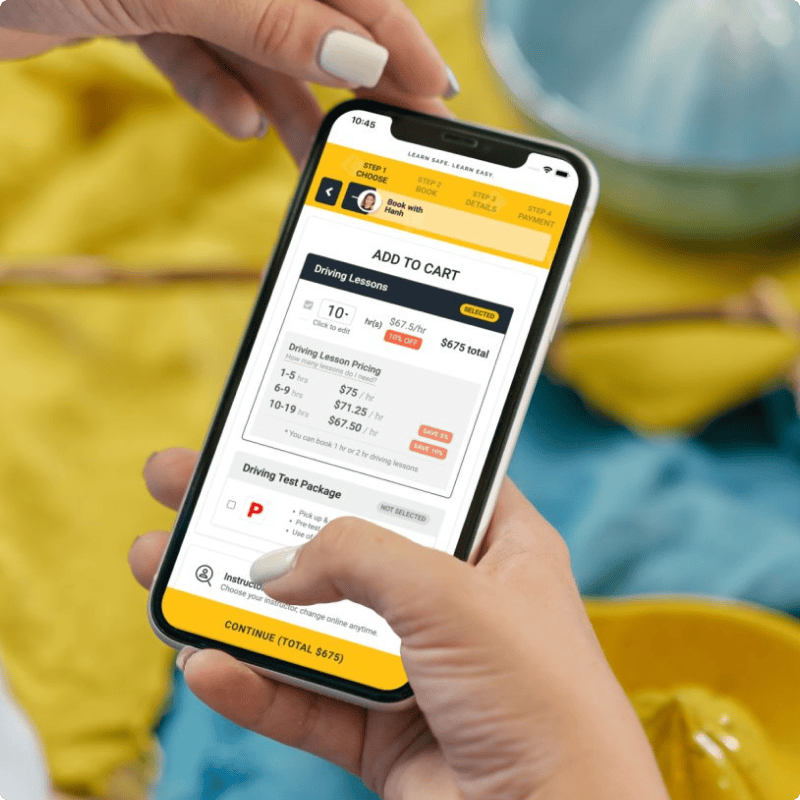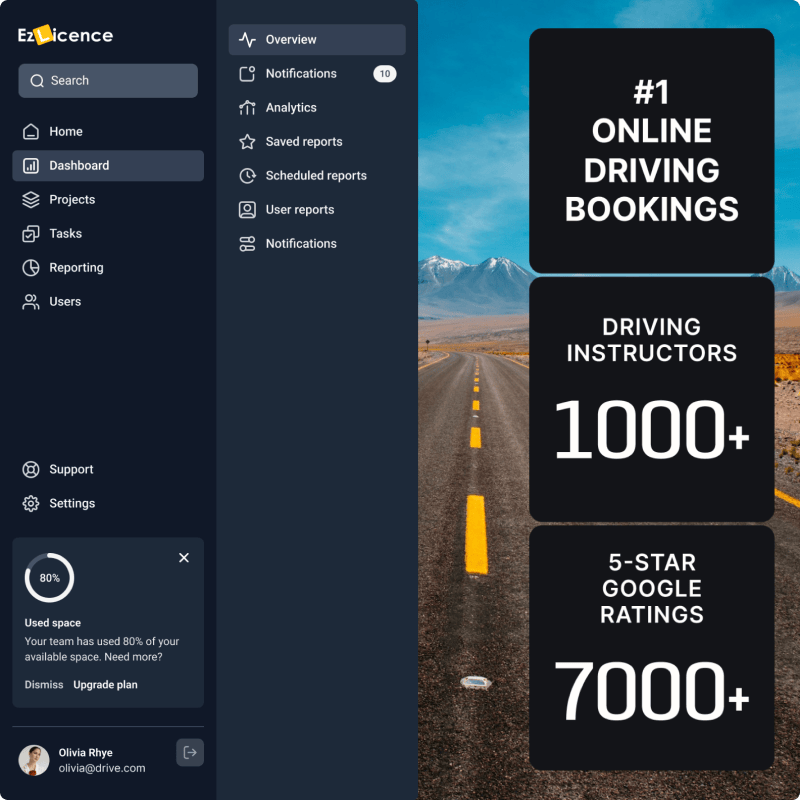Marketplace App Development
We built EzLicence - Australia's leading driver education marketplace facilitating $100M+ in bookings. Expert marketplace app developers specialising in two-sided platforms with complex payments, vendor management, ratings systems, and real-time booking. Web apps or mobile apps - we build what your marketplace actually needs.
Our Proven Track Record:
- Apple Best of Developers, Watch App & TV App of the Year
- 20+ apps featured in the App Store and Google Play
- Over 30 Australian and global awards


Expert Market App Development for Two-Sided Platforms
Marketplace app development is fundamentally different from standard app development. You're not building for one user type - you're building for two (or more): buyers and sellers, service providers and customers, hosts and guests, instructors and students. Each side has different needs, different workflows, and different success metrics. Get the balance wrong, and your marketplace never achieves liquidity - the critical mass of supply and demand required for sustainable growth.
We've built marketplace platforms across diverse verticals: EzLicence (connecting learner drivers with driving instructors - $100M+ in facilitated bookings), fitness marketplaces (trainers and clients), service marketplaces (professionals and customers), and rental platforms (owners and renters). As specialised marketplace app developers, we understand the unique challenges: cold start problems (which side do you build first?), payment complexity (escrow, splits, fees, disputes), trust and safety (ratings, reviews, verification, insurance), and regulatory compliance (licensing, background checks, tax reporting).
When Web Apps Work Best for Marketplaces
EzLicence proves web apps can power successful marketplaces. Choose web app development when:
- Desktop Research & Booking Behavior: Users research and book from computers (B2B services, professional services, education, real estate, high-consideration purchases requiring comparison)
- No Mobile-Specific Features Required: Marketplace doesn't need GPS tracking, camera access, push notifications, or offline functionality critical to user experience
- Complex Workflows: Multi-step processes with extensive information input (detailed profiles, lengthy applications, document uploads) work better on larger screens
- Faster Launch & Iteration: Single codebase, faster development, easier updates—critical for MVP marketplace validation where you're testing supply-demand dynamics
- Cost Efficiency: 60% less expensive than native mobile apps, allowing more budget for marketplace growth (customer acquisition, vendor incentives)
When Mobile Apps Are Essential for Marketplaces
Some marketplaces fundamentally require mobile apps. Choose mobile app development when:
- Real-Time Location Critical: Ride-sharing, food delivery, logistics, on-demand services requiring GPS tracking and proximity matching
- Time-Sensitive Transactions: Immediate booking confirmation, real-time availability updates, instant notifications affecting user decisions
- In-Field Usage: Service providers using app while working (delivery drivers, field technicians, mobile services)
- Camera & Scanning: Product verification, QR codes, document scanning, photo uploads essential to transaction flow
- Consumer-Facing Frequency: Daily usage patterns where mobile app presence improves engagement (food ordering, transportation, daily services)
Hybrid Approach: Progressive Web Apps (PWAs)
Progressive Web Apps offer middle ground—web apps with mobile-like features:
- Install to home screen (looks like native app)
- Push notifications (re-engage users)
- Offline functionality (basic features without connectivity)
- Camera and GPS access (when needed)
- Single codebase (web + mobile-like experience)
- No App Store approval required (faster iteration)
PWAs cost 40-60% less than native apps whilst providing 80-90% of mobile functionality. Ideal for marketplace MVPs testing product-market fit before committing to full native development.
Why Marketplace Founders Choose PixelForce Developers
A critical decision in marketplace app development: Do you need a mobile app or will a web app suffice? Many founders assume marketplaces require mobile apps—they don't always. EzLicence has facilitated over $100M in bookings as a web application because the core booking workflow doesn't require mobile-specific features like GPS tracking, push notifications for time-sensitive actions, or camera access for instant verification. We help you determine the right platform based on your marketplace's actual user behavior—not assumptions.
- Proven Marketplace Expertise: Built EzLicence from concept to $100M+ in facilitated bookings. We understand marketplace dynamics - supply-demand balancing, liquidity thresholds, network effects, and growth loops that make marketplaces defensible businesses.
- Platform Agnostic Recommendation: We recommend web, mobile, or hybrid based on your marketplace's actual needs - not what generates maximum development fees. EzLicence's web app success proves expensive isn't always better.
- Complex Payment Systems: Expert integration with Stripe Connect, PayPal Marketplace, escrow services, split payments, vendor payouts, fee structures, tax reporting (1099s), and dispute resolution - the financial plumbing marketplaces require.
- Trust & Safety Systems: Built-in verification flows (identity, credentials, background checks), rating and review systems (preventing gaming, handling disputes), insurance integrations, fraud detection, and moderation tools protecting both sides of your marketplace.
- Regulatory Compliance: Experience navigating complex regulatory environments - licensing requirements, background checks, insurance minimums, tax collection and remittance, data privacy (GDPR, CCPA), and industry-specific regulations.




Marketplace App Development Services
Two-Sided Marketplace Platforms
Classic two-sided marketplaces connecting buyers with sellers, service providers with customers, or supply with demand. Core features include dual registration flows (separate onboarding for each side), search and discovery (finding right match from available supply), booking and scheduling systems, payment processing with escrow, ratings and reviews (bilateral—both sides rate each other), messaging between parties, and transaction management (confirmations, modifications, cancellations).
Common Verticals: Service marketplaces (professionals offering expertise), rental marketplaces (owners and renters), education marketplaces (instructors and students—like EzLicence), freelance marketplaces (talent and clients), and local services (connecting nearby providers with customers).
Multi-Sided Marketplace Platforms
Complex marketplaces involving three or more participant types. Examples include delivery marketplaces (restaurants, delivery drivers, customers), event platforms (venues, organisers, attendees, vendors), B2B2C marketplaces (manufacturers, retailers, consumers), and ecosystem platforms (multiple complementary service providers serving same customer).
Additional Complexity: Coordinating multiple stakeholders, complex payment splits (multiple parties receiving portions), varied permission systems (each user type sees different interface), and intricate business rules (interactions between different participant types).
Service Marketplace Development
Connecting service providers (professionals, freelancers, skilled workers) with customers needing their expertise. Features include professional profiles and portfolios, credential verification and background checks, availability calendars and booking systems, quote requests and proposal systems, project management tools, milestone-based payments, and dispute resolution.
EzLicence Deep Dive: Australia's leading driver education marketplace connecting learner drivers with licensed driving instructors. Web app handling complex booking workflows including instructor profiles with credentials, availability management, multi-lesson package bookings, student progress tracking, automated reminders, payment processing with instructor payouts, and regulatory compliance (instructor licensing, insurance verification). Facilitated $100M+ in bookings proving web apps can power sophisticated marketplaces when mobile features aren't essential to core workflow.
Rental & Sharing Economy Marketplaces
Platforms enabling temporary access to assets, properties, or services. Features include listing creation with photos and descriptions, calendar availability management, pricing tools (dynamic pricing, discounts, packages), booking and reservation systems, payment processing with security deposits, insurance integrations, identity verification, property/asset verification, and review systems preventing fraudulent listings.
Examples: Property rentals (short-term, vacation), equipment rentals (tools, vehicles, electronics), space rentals (parking, storage, workspaces), and peer-to-peer lending (various assets).
On-Demand & Instant Booking Marketplaces
Real-time marketplaces requiring immediate matching and mobile functionality. Features include GPS-based proximity matching, real-time availability tracking, instant booking confirmation, push notifications (critical for time-sensitive actions), live tracking (showing provider location), in-app messaging (coordinating meetups), and payment automation (frictionless checkout).
Mobile App Required: On-demand marketplaces fundamentally require mobile apps—desktop web apps don't support real-time GPS, push notifications, and in-field usage patterns essential to these models. Examples: ride-sharing, food delivery, beauty services, home services, and mobile mechanics.
B2B Marketplace Development
Enterprise marketplaces connecting businesses with suppliers, service providers, or partners. Features include company profiles and verification, RFP/RFQ systems (request for proposal/quote), bulk ordering and contract management, invoicing and NET payment terms, approval workflows (multiple stakeholders), integration with enterprise systems (ERP, procurement), and analytics and reporting (spend analysis, supplier performance).
Complexity Drivers: Longer sales cycles, multiple decision makers, custom pricing and contracts, integration requirements, and security/compliance standards.
Essential Marketplace App Features
Dual User Registration & Profiles
Separate onboarding flows for supply and demand sides:
- Supply side: Detailed profiles, credential verification, portfolio/examples, availability setup, payment details
- Demand side: Basic profiles, payment methods, preferences, saved searches
- Progressive disclosure (don't overwhelm with upfront requirements)
- Email and phone verification
- Social login options (reduce friction)
- Profile completion tracking (incentivise completion)
Search, Filter & Discovery
Helping users find right match from available supply:
- Keyword search across listings
- Advanced filtering (price, location, category, features, availability)
- Sorting options (relevance, price, ratings, distance)
- Map-based browsing (location-dependent marketplaces)
- Personalised recommendations (based on history, preferences)
- Saved searches and favourites
Booking & Transaction Management
Facilitating exchanges between marketplace sides:
- Availability calendar (real-time updates)
- Instant booking vs. request-to-book
- Booking confirmations and reminders
- Modification and cancellation flows
- Cancellation policies and penalties
- Transaction history and receipts
Payment Processing & Escrow
Complex payment flows unique to marketplaces:
- Secure payment collection (cards, wallets, bank transfers)
- Escrow holding (funds held until service completion)
- Automated payouts to vendors/providers
- Split payments (marketplace fee + vendor payment)
- Refund and dispute handling
- Multi-currency support (international marketplaces)
- Tax collection and reporting (1099 generation)
Ratings & Review Systems
Building trust through social proof:
- Bilateral reviews (both sides rate each other)
- Star ratings with written reviews
- Verified purchaser badges
- Review moderation (preventing abuse)
- Response system (providers can respond to reviews)
- Aggregate ratings (overall scores, badges for top performers)
Messaging & Communication
Facilitating coordination between marketplace parties:
- In-platform messaging (keeping communication on-platform)
- Email and SMS notifications
- Attachment support (photos, documents)
- Read receipts and typing indicators
- Automated messages (booking confirmations, reminders)
- Message templates (common questions/responses)
Trust & Safety Features
Protecting both sides of marketplace:
- Identity verification (government ID, selfie matching)
- Background checks (criminal, credit for certain verticals)
- Credential verification (licenses, certifications)
- Insurance verification and integration
- Fraud detection algorithms
- User reporting and flagging
- Content moderation (listings, photos, reviews)
Analytics & Dashboards
Data-driven marketplace optimisation:
- Vendor dashboards (earnings, bookings, reviews)
- Customer dashboards (history, favourites, recommendations)
- Admin analytics (GMV, take rate, cohorts, liquidity metrics)
- Performance metrics (conversion rates, booking completion)
- Financial reporting (revenue, payouts, tax documents)
Marketplace App Development Process
Phase 1: Marketplace Strategy & Model Validation (Weeks 1-3)
Marketplace app development begins with strategic clarity. We help you define your marketplace model (two-sided vs. multi-sided), identify which side to build first (supply or demand?), determine value proposition for each side (why participate?), analyse competitive landscape and differentiation, validate unit economics (transaction value, take rate, CAC, LTV), and decide platform approach (web app vs. mobile app vs. hybrid).
Critical Questions: Which side is harder to acquire (focus there first)? What's your chicken-and-egg solution (how do you bootstrap liquidity)? What's your defensibility (why won't competitors copy you)? What regulatory compliance is required (licensing, insurance, background checks)?
Phase 2: Marketplace UX/UI Design (Weeks 4-8)
Designing for multiple user types with different needs. Supply side design (listing creation, availability management, earnings tracking), demand side design (search, booking, payment flows), admin design (moderation, analytics, vendor management), and trust-building elements (verification badges, reviews, guarantees). We create separate prototypes for each user type, testing workflows with representative users before development.
Design Principles: Reduce friction for demand side (easy browsing, quick booking), provide value to supply side (simple listing creation, clear earnings), establish trust quickly (social proof, verification, guarantees), and optimise for conversions (checkout flow, payment collection).
Phase 3: Development & Integration (Weeks 9-16)
Building your marketplace platform with technical excellence. Platform development (web app, mobile app, or PWA based on strategy), payment integration (Stripe Connect, PayPal Marketplace, or custom), messaging systems (real-time or email-based), notification infrastructure (transactional emails, SMS, push notifications), search and filtering (Elasticsearch, Algolia, or custom), map integration (Google Maps, Mapbox for location-based marketplaces), and admin tools (moderation, analytics, vendor management).
Technical Focus: Scalable architecture (handling growth in listings and transactions), secure payment flows (PCI compliance, escrow management), reliable notifications (booking confirmations must reach users), and performant search (users must find relevant listings quickly).
Phase 4: Pilot Launch with Limited Vendors/Customers (Weeks 16-20)
Marketplaces require careful rollout. We launch with limited supply and demand (10-50 vendors, 100-500 customers), gathering feedback on both sides of marketplace, validating unit economics with real transactions, identifying friction points in booking/transaction flows, testing payment flows end-to-end, and refining based on early user behavior.
Metrics to Track: Supply activation rate (% of vendors completing listings), demand conversion rate (% of visitors booking), transaction completion rate (% of bookings completing successfully), and liquidity (can customers reliably find what they want?).
Phase 5: Full Launch & Growth (Week 20+)
Scaling both sides of marketplace systematically. Geographic expansion (if location-based), category expansion (adding new verticals or services), feature iteration (based on user feedback and data), marketplace optimisation (improving conversion rates, reducing friction), and vendor success programs (helping top performers succeed drives supply quality).
Growth Strategy: Typically focus on supply side first (harder to acquire, drives marketplace quality), then drive demand through marketing, referrals, and SEO. Network effects compound over time—each new vendor makes marketplace more valuable to customers, attracting more customers who attract more vendors.
Marketplace Monetisation Models
Commission/Take Rate (Most Common)
Marketplace takes percentage of each transaction. Typical ranges: 5-30% depending on vertical, transaction value, and competitive dynamics. EzLicence uses commission model—taking percentage of each lesson booking. Advantages include aligned incentives (marketplace succeeds when vendors succeed), scales with GMV (gross merchandise value), and no upfront vendor cost (lowers barrier to supply side participation).
Considerations: What's sustainable take rate for your vertical? How does it compare to competitors? Can you justify rate through value-add services?
Subscription Model
Vendors pay monthly/annual fee for marketplace access. Common in B2B marketplaces, professional service marketplaces, and niche verticals. Advantages include predictable recurring revenue (easier to forecast), vendor commitment (paying subscription signals seriousness), and ability to offer tiered plans (basic, premium, enterprise with different features).
Challenges: Higher barrier to vendor acquisition (upfront cost), must provide significant value justifying subscription, and revenue not directly tied to vendor success.
Listing Fees
Vendors pay to create listings (per listing or featured listings). Common in classifieds, real estate, recruiting. Advantages include early monetisation (revenue before transaction completion), encourages listing quality (vendors think twice about spam), and works for low-transaction-value items.
Drawbacks: Reduces supply side participation (friction to listing), doesn't align with vendor success (vendor pays regardless of sale), and can encourage competitors with free listing models.
Freemium Model
Basic marketplace access free, premium features paid. Examples: featured listings (increased visibility), advanced analytics, priority support, lower commission rates for paying vendors, and unlimited listings (free tier has caps).
Best For: Building supply side quickly (no barrier to entry), converting successful vendors to paid tiers (once they see value), and offering clear value differentiation between free and paid.
Hybrid Models
Combining multiple monetisation approaches. Example: Low commission + subscription for premium features, or free basic listings + paid featured placement + transaction commission. Diversifies revenue and optimises for different vendor segments.
Web App vs Mobile App: Cost Comparison
Web App Marketplace Development
Initial Development: $150K-$300K depending on complexity
Timeline: 4-8 months
Advantages:
- Single codebase (easier maintenance)
- Faster iteration (no App Store approval)
- Better for desktop research and booking behavior
- SEO-friendly (discoverable via search engines)
- Universal access (works on any device with browser)
- Lower ongoing costs
Best For: Service marketplaces, B2B platforms, rental marketplaces, education marketplaces (like EzLicence), and any marketplace where mobile-specific features aren't essential.
Native Mobile App Marketplace Development
Initial Development: $250K-$500K (iOS + Android)
Timeline: 8-12 months
Advantages:
- Real-time GPS and location services
- Push notifications (critical for time-sensitive actions)
- Camera and hardware access
- Offline functionality
- Premium user experience
- App Store presence and discoverability
Best For: On-demand marketplaces (ride-sharing, delivery), location-based services, marketplaces requiring in-field usage, and consumer-facing daily-use platforms.
Progressive Web App (PWA) Marketplace
Initial Development: $200K-$350K
Timeline: 5-9 months
Advantages:
- Mobile-like features (push notifications, home screen install)
- Camera and GPS access (when needed)
- Works across all devices
- No App Store approval delays
- SEO benefits of web apps
- 40-60% cost savings versus native
Best For: Marketplace MVPs testing product-market fit, platforms needing some mobile features but not full native functionality, and budget-conscious founders.